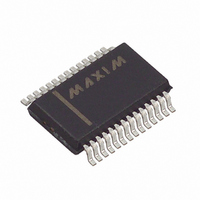MAX4588CAI Maxim Integrated Products, MAX4588CAI Datasheet - Page 15

MAX4588CAI
Manufacturer Part Number
MAX4588CAI
Description
IC MUX DUAL RF VIDEO 4CH 28-SSOP
Manufacturer
Maxim Integrated Products
Series
4000r
Datasheet
1.MAX4588CAI.pdf
(20 pages)
Specifications of MAX4588CAI
Function
Video Multiplexer/Demultiplexer
Circuit
2 x 4:1
On-state Resistance
60 Ohm
Voltage Supply Source
Single, Dual Supply
Voltage - Supply, Single/dual (±)
2.7 V ~ 12 V, ± 2.7 V ~ 6 V
Operating Temperature
0°C ~ 70°C
Mounting Type
Surface Mount
Package / Case
28-SSOP
Lead Free Status / RoHS Status
Contains lead / RoHS non-compliant
Available stocks
Company
Part Number
Manufacturer
Quantity
Price
Part Number:
MAX4588CAI
Manufacturer:
MAXIM/美信
Quantity:
20 000
Company:
Part Number:
MAX4588CAI+
Manufacturer:
Maxim Integrated Products
Quantity:
135
Company:
Part Number:
MAX4588CAI+
Manufacturer:
MAX
Quantity:
44
The power-down sequence is the opposite of the
power-up sequence. That is, the V
must go to zero potential before (or simultaneously
with) the V- then V+ supplies. The Absolute Maximum
Ratings must always be observed in order to ensure
proper operation.
Satisfactory high-frequency operation requires that
careful consideration be given to grounding. For most
applications, a ground plane is strongly recom-
mended, and all GND pins must connect to it with
solid copper. While the V+ and V- power-supply pins
are common to all switches in a given package, each
input is separated with ground pins that are not inter-
nally connected to each other. This contributes to the
overall high-frequency performance by reducing chan-
nel-to-channel crosstalk. All the GND pins have ESD
diodes to V+ and V-.
In systems that have separate digital and analog (sig-
nal) grounds, connect all GND pins to analog signal
ground. Preserving a good signal ground is much more
important than preserving a digital ground. Ground cur-
rent is only a few nanoamperes.
The digital inputs have voltage thresholds determined by
V
old). With +5V applied to V
ensuring compatibility with TTL- and CMOS-logic drivers.
A ground plane is mandatory for satisfactory high-
frequency operation. Prototyping using hand wiring or
wire-wrap boards is not recommended. Connect all
GND pins to the ground plane with solid copper. (The
GND pins extend the high-frequency ground through
the package wire-frame, into the silicon itself, thus
improving isolation.) Make the ground plane solid metal
underneath the device, without interruptions. There
should be no traces under the device itself. For DIP
packages, this applies to both sides of a two-sided
board. Failure to observe this has a minimal effect on
the “on” characteristics of the switch at high frequen-
cies, but will degrade the off-isolation and crosstalk.
When using the MAX4588’s SO package on PC boards
with a buried ground plane, connect each GND pin to the
ground plane with a separate via. Do not share this via
with any other ground path. Providing a ground via on
both sides of the SMT land further enhances the off-isola-
tion by lowering the parasitic inductance. The DIP pack-
age can have the through-holes directly tied to the buried
plane, or thermally relieved as required to meet manufac-
L
and GND (V- does not influence the logic-level thresh-
______________________________________________________________________________________
L
DC Ground Considerations
AC Ground and Bypassing
, the threshold is about 1.6V,
Dual 4-Channel RF/Video Multiplexer
L
and logic inputs
Grounding
Low-Voltage, High-Isolation,
turability requirements. Again, do not use the through-
hole pads as the current path for any other components.
Bypass all V+ and V- pins to the ground plane with sur-
face-mount 0.01µF capacitors. Locate these capacitors
as close as possible to the pins on the same side of the
board as the device. Do not use feedthroughs or vias
for bypass capacitors. If board layout dictates that the
bypass capacitors are mounted on the opposite side of
the PC board, use short feedthroughs or vias, directly
under the V+ and V- pins. Use multiple vias if possible.
If V- is 0, connect it directly to the ground plane with
solid copper. Keep all traces short.
Keep all signal leads as short as possible. Separate all
signal leads from each other, and keep them away from
any other traces that could induce interference.
Separating the signal traces with generously sized
ground wires also helps minimize interference. Routing
signals via coaxial cable, terminated as close to the
MAX4588 as possible, provides the highest isolation.
IC sockets degrade high-frequency performance and
should not be used if signal bandwidth exceeds 5MHz.
Surface-mount parts, having shorter internal lead
frames, provide the best high-frequency performance.
Keep all bypass capacitors close to the device, and
separate all signal leads with ground planes. Such
grounds tend to be wedge-shaped as they get closer to
the device. Use vias to connect the ground planes on
each side of the board, and place the vias in the apex of
the wedge-shaped grounds that separate signal leads.
Logic-level signal lead placement is not critical.
The MAX4588 is intended for use in 75Ω systems,
where the inputs are terminated external to the IC and
the COM terminals see an impedance of 600Ω or high-
er. The MAX4588 can operate in 50Ω and 75Ω systems
with terminations through the IC. However, variations in
R
The graphs shown in Typical Operating Characteristics
for crosstalk and off-isolation are taken on adjacent
channels. The adjacent channel is the worst-case con-
dition. For example, NO1 has the worst off-isolation to
COM1 due to their proximity. Furthermore, NO1 has the
most crosstalk to NO2, and the least crosstalk to NO4.
Choosing channels wisely necessitates separating the
most sensitive channels from the most offensive.
Conversely, the above information also applies to the
NO5–NO8 inputs to the COM2 pin.
ON
and R
ON
flatness cause nonlinearities.
Crosstalk and Off-Isolation
Impedance Matching
Signal Routing
Board Layout
15













